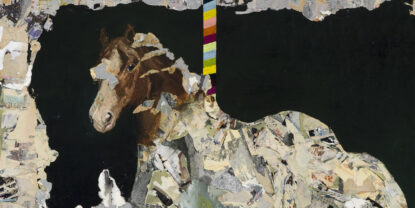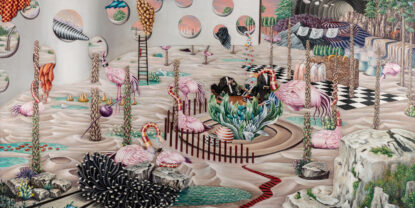Two-Person Show: Sogol Ahadi & Nasim Shoja
Group Exhibition
August 26 — September 04, 2022
Similar to poetry, which is formed by a combination of often unlikely words, Sogol Ahadi and Nasim Shoja, previously introduced in the “Episode” exhibition series, seek to create a coherent narrative from a subjective realm by putting together different visual fractures in a two-person show. In Sogol’s works, childlike wonder emerges from blackness and holes, and Nasim’s paintings are like a fantastic journey that begins in fragmented, defamiliarized narratives; intending not to reach a certain destination. Sogol reduces images and Nasim adds details to them, while they both stack them up and at times juxtapose them to make a map out of images to interpret their memories and imaginations. Their works flow constantly, as studies are erased and new images are added, so that finally things can make sense in their proper position.
In “The Rental Horse” series, consisting of two parts, “Ride” and “Gallop,” both created in the same period, Sogol Ahadi uses various collage techniques. Photographs and images from magazines in “Ride” emerge from pitch-black darkness. Destroying images and recycling pieces in her works is a struggle with the temptation to sink into darkness; like being tempted to scratch a newly healed wound. In the meantime, the viewer’s gaze gets caught in the holes of “Gallop.” The cavities are repeated in the weak fabric of the images. It is as if memory termites dig numerous holes into Sogol’s soul. The accumulation of empty space in her works is the invasion of the past into the privacy of the present; like a shadow, the past is an inseparable part of her life.
In the “Living on the Orbit of Inexistence” series, Nasim Shoja appropriates works of art and literature, which are put together with the artist’s dreams and mental images with a syncretistic approach. In Nasim’s works, parts are not supposed to form a single whole to lead the audience to the conclusion of the story in an orderly fashion. Each narrative continues to live in its own unique world to make an allegory of an uncertain contemporary world; sub-narratives that invite the audience to join in the process of storytelling, so that they can walk into Nasim’s surreal purgatory to find an opportunity to fantasize.
The layered depths of Nasim’s paintings, which is similar to Sogol’s memory-soaked collages, do not easily reveal the secret of their desires and lived experience to the audience; they, rather, cleverly hide it in a corner of the work, underneath stacks of images, so that the works turn into a meeting point for remembrance.

